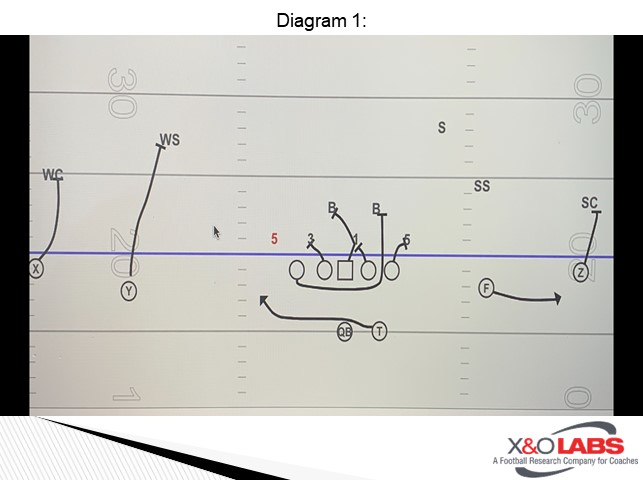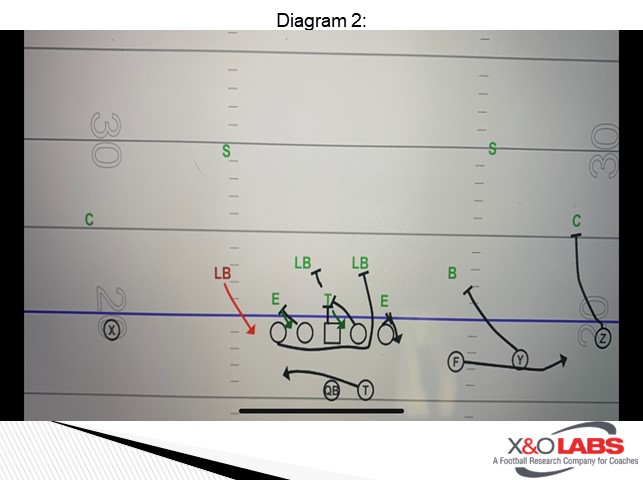By Kyle Wagner
Offensive Coordinator & QB Coach
Lutheran North High School (MO)
Twitter: @THECoachKdub
The QB dart play is an excellent addition to any spread offensive attack. The dart play in its essence is a "tackle iso" play. It stresses defenses preparing to handle inside zone read because the defensive end being read is now away from the back. The play is also versatile in the way that your back and quarterback can switch roles from year to year depending on whom you want to be the primary ball-carrier when the play is called. QB dart can be effectively tagged with key game RPOs to be even more deadly and save the offense valuable yards in case of a missed block or assignment. This play was a key part of our 14-0 season and provided us with an answer in critical moments throughout the playoffs.
Why Run QB Dart?
The QB dart is a rather inexpensive play to install. The blocking assignments are rather simple especially if you already incorporate any iso into your offense. It is a great way to allow your dual-threat Quarterback to make easy decisions and get him out in space with a lead blocker. The misdirection of the play makes it tough for the defender to remain consistent in their eye discipline. Also, being able to tag RPOs onto the play makes it even more of a headache for the defense both in preparation and on the field. The QB dart play is also a way to break inside zone read tendencies, which is what originally intrigued me. It’s an Inside Zone tendency breaker because usually we are reading the Defensive End on the same side as the back and now we are reading the end away from the back. The games defenses play to stop the Zone play with exchanging gaps are now less effective. In a day and age where explosive plays are king, QB dart is just that. Every run is a big play possibility unless the defense concedes numbers on the perimeter. Finally, the play is versatile, and it can be very simple or you can use motions, etc. to make it more complex.
Coaching Points:
The major coaching point at getting good at running this play is the same as most, reps! As the quarterback’s coach, we try to get at least 10-15 minutes a day of working our mesh at an extremely fast pace. We will rep all our run read plays at least four or five times each way during this period. During the period we have our offensive line hose rolled out and have a defender playing as the read defender. The job of the defender is to try to confuse the quarterback into making a mistake. The QB meshes with the back keeping his eyes on the defender. I tell him to "feel" the flow of the defender and trust his instincts. It is important that if you have a QB who can run that you tell him to keep it unless the defensive end can get to him as opposed to keep it if the defensive end takes the back. The fact that we only must spend a few reps on the play is why I consider it an inexpensive, explosive play!
Game Planning the Dart Scheme:
You want to run to the side of the 1-technique vs a split look (5-3-1-5 defensive front). If you are a heavy spread team you will see this look quite a bit. If you face a 30-front that slants, you just have to find out what formation dictates the way that they slant and run the QB dart towards the way they are slanting as it will become their "1-5 bubble". PST will block the play-side defensive end. PSG will work a double-team with the center on the 1-technique. The center will block on a double-team and work back to backside backer. BSG takes the 3-technique to turn him out and BST pulls for play side backer. QB reads the backside end for a keep or give read. If the defensive end attacks the back, the QB keeps the ball and follows the tackle on the Dart play. (It is also effective to have the PST pass set to induce a pass rush by the PSE.)


Variations:
To add in a built-in safety net into the play, add key screen RPOs that will be thrown off the overhang defender. Here is an example of how the key screen saved us 13 yards in our semifinal game.
Some of the key variations to spice up the play a bit and make it look like a different play are using jet motions to provide misdirection and utilizing an H-back for additional blocking. You will see both in the play below. We end up getting called for holding on the edge then come back and score the next play on QB Dart from a different look adjusting to a different front. Versatility.
Using different formations to manipulate the defensive front into the look you want is pivotal and using an H-back is a sure-fire way to get the 1 tech where you need him.
The final adjustment that we utilized this season was to leave the BST on the backside end and pull the H back for play side backer. This was an adjustment to stop defensive ends from trying to shoot the gap vacated by the pulling tackle. Making this adjustment allowed us to run QB dart from empty and opened key screens as well.
To study game film of this concept, click on the video below:
Offensive Coordinator & QB Coach
Lutheran North High School (MO)
Twitter: @THECoachKdub
The QB dart play is an excellent addition to any spread offensive attack. The dart play in its essence is a "tackle iso" play. It stresses defenses preparing to handle inside zone read because the defensive end being read is now away from the back. The play is also versatile in the way that your back and quarterback can switch roles from year to year depending on whom you want to be the primary ball-carrier when the play is called. QB dart can be effectively tagged with key game RPOs to be even more deadly and save the offense valuable yards in case of a missed block or assignment. This play was a key part of our 14-0 season and provided us with an answer in critical moments throughout the playoffs.
Why Run QB Dart?
The QB dart is a rather inexpensive play to install. The blocking assignments are rather simple especially if you already incorporate any iso into your offense. It is a great way to allow your dual-threat Quarterback to make easy decisions and get him out in space with a lead blocker. The misdirection of the play makes it tough for the defender to remain consistent in their eye discipline. Also, being able to tag RPOs onto the play makes it even more of a headache for the defense both in preparation and on the field. The QB dart play is also a way to break inside zone read tendencies, which is what originally intrigued me. It’s an Inside Zone tendency breaker because usually we are reading the Defensive End on the same side as the back and now we are reading the end away from the back. The games defenses play to stop the Zone play with exchanging gaps are now less effective. In a day and age where explosive plays are king, QB dart is just that. Every run is a big play possibility unless the defense concedes numbers on the perimeter. Finally, the play is versatile, and it can be very simple or you can use motions, etc. to make it more complex.
Coaching Points:
The major coaching point at getting good at running this play is the same as most, reps! As the quarterback’s coach, we try to get at least 10-15 minutes a day of working our mesh at an extremely fast pace. We will rep all our run read plays at least four or five times each way during this period. During the period we have our offensive line hose rolled out and have a defender playing as the read defender. The job of the defender is to try to confuse the quarterback into making a mistake. The QB meshes with the back keeping his eyes on the defender. I tell him to "feel" the flow of the defender and trust his instincts. It is important that if you have a QB who can run that you tell him to keep it unless the defensive end can get to him as opposed to keep it if the defensive end takes the back. The fact that we only must spend a few reps on the play is why I consider it an inexpensive, explosive play!
Game Planning the Dart Scheme:
You want to run to the side of the 1-technique vs a split look (5-3-1-5 defensive front). If you are a heavy spread team you will see this look quite a bit. If you face a 30-front that slants, you just have to find out what formation dictates the way that they slant and run the QB dart towards the way they are slanting as it will become their "1-5 bubble". PST will block the play-side defensive end. PSG will work a double-team with the center on the 1-technique. The center will block on a double-team and work back to backside backer. BSG takes the 3-technique to turn him out and BST pulls for play side backer. QB reads the backside end for a keep or give read. If the defensive end attacks the back, the QB keeps the ball and follows the tackle on the Dart play. (It is also effective to have the PST pass set to induce a pass rush by the PSE.)


Variations:
To add in a built-in safety net into the play, add key screen RPOs that will be thrown off the overhang defender. Here is an example of how the key screen saved us 13 yards in our semifinal game.
Some of the key variations to spice up the play a bit and make it look like a different play are using jet motions to provide misdirection and utilizing an H-back for additional blocking. You will see both in the play below. We end up getting called for holding on the edge then come back and score the next play on QB Dart from a different look adjusting to a different front. Versatility.
Using different formations to manipulate the defensive front into the look you want is pivotal and using an H-back is a sure-fire way to get the 1 tech where you need him.
The final adjustment that we utilized this season was to leave the BST on the backside end and pull the H back for play side backer. This was an adjustment to stop defensive ends from trying to shoot the gap vacated by the pulling tackle. Making this adjustment allowed us to run QB dart from empty and opened key screens as well.
To study game film of this concept, click on the video below:








